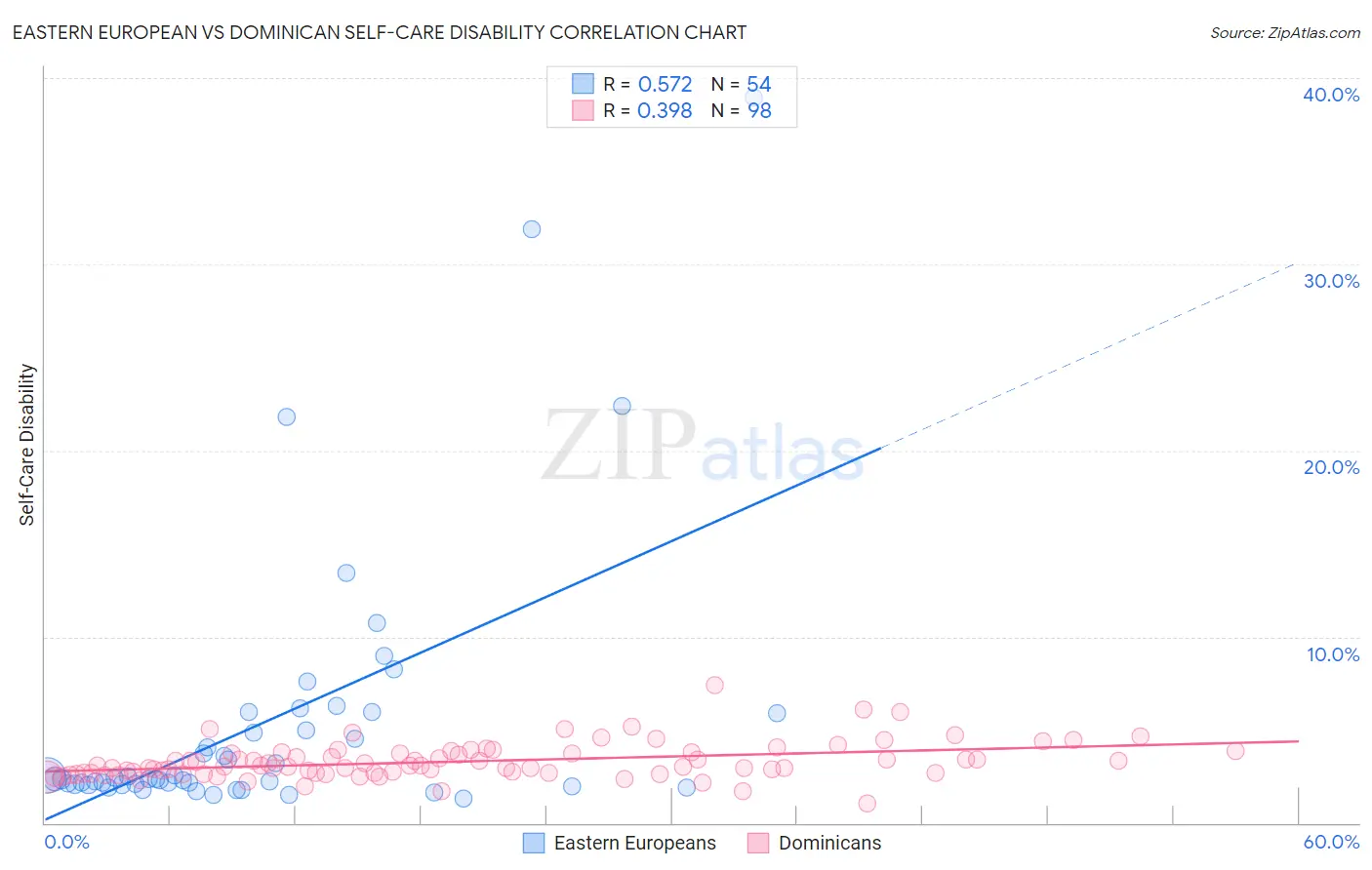Eastern European vs Dominican Self-Care Disability
COMPARE
Eastern European
Dominican
Self-Care Disability
Self-Care Disability Comparison
Eastern Europeans
Dominicans
2.3%
SELF-CARE DISABILITY
99.2/ 100
METRIC RATING
72nd/ 347
METRIC RANK
3.1%
SELF-CARE DISABILITY
0.0/ 100
METRIC RATING
341st/ 347
METRIC RANK
Eastern European vs Dominican Self-Care Disability Correlation Chart
The statistical analysis conducted on geographies consisting of 460,402,865 people shows a substantial positive correlation between the proportion of Eastern Europeans and percentage of population with self-care disability in the United States with a correlation coefficient (R) of 0.572 and weighted average of 2.3%. Similarly, the statistical analysis conducted on geographies consisting of 354,514,623 people shows a mild positive correlation between the proportion of Dominicans and percentage of population with self-care disability in the United States with a correlation coefficient (R) of 0.398 and weighted average of 3.1%, a difference of 31.7%.

Self-Care Disability Correlation Summary
| Measurement | Eastern European | Dominican |
| Minimum | 1.3% | 1.0% |
| Maximum | 39.0% | 7.4% |
| Range | 37.7% | 6.3% |
| Mean | 5.4% | 3.3% |
| Median | 2.4% | 3.0% |
| Interquartile 25% (IQ1) | 2.1% | 2.7% |
| Interquartile 75% (IQ3) | 5.9% | 3.7% |
| Interquartile Range (IQR) | 3.8% | 1.1% |
| Standard Deviation (Sample) | 7.4% | 0.96% |
| Standard Deviation (Population) | 7.3% | 0.96% |
Similar Demographics by Self-Care Disability
Demographics Similar to Eastern Europeans by Self-Care Disability
In terms of self-care disability, the demographic groups most similar to Eastern Europeans are Asian (2.3%, a difference of 0.030%), Immigrants from Egypt (2.3%, a difference of 0.030%), Immigrants from Northern Europe (2.3%, a difference of 0.070%), Immigrants from Switzerland (2.3%, a difference of 0.090%), and Immigrants from Zaire (2.3%, a difference of 0.10%).
| Demographics | Rating | Rank | Self-Care Disability |
| Brazilians | 99.3 /100 | #65 | Exceptional 2.3% |
| Immigrants | Argentina | 99.3 /100 | #66 | Exceptional 2.3% |
| South Africans | 99.3 /100 | #67 | Exceptional 2.3% |
| Immigrants | Zaire | 99.2 /100 | #68 | Exceptional 2.3% |
| Immigrants | Norway | 99.2 /100 | #69 | Exceptional 2.3% |
| Immigrants | Northern Europe | 99.2 /100 | #70 | Exceptional 2.3% |
| Asians | 99.2 /100 | #71 | Exceptional 2.3% |
| Eastern Europeans | 99.2 /100 | #72 | Exceptional 2.3% |
| Immigrants | Egypt | 99.1 /100 | #73 | Exceptional 2.3% |
| Immigrants | Switzerland | 99.1 /100 | #74 | Exceptional 2.3% |
| Immigrants | Netherlands | 99.1 /100 | #75 | Exceptional 2.3% |
| Immigrants | China | 99.1 /100 | #76 | Exceptional 2.3% |
| Immigrants | Middle Africa | 99.0 /100 | #77 | Exceptional 2.3% |
| Immigrants | Ireland | 99.0 /100 | #78 | Exceptional 2.3% |
| Immigrants | Kenya | 99.0 /100 | #79 | Exceptional 2.3% |
Demographics Similar to Dominicans by Self-Care Disability
In terms of self-care disability, the demographic groups most similar to Dominicans are Immigrants from Cabo Verde (3.1%, a difference of 0.26%), Immigrants from Dominican Republic (3.0%, a difference of 0.59%), Cape Verdean (3.0%, a difference of 0.98%), Choctaw (3.0%, a difference of 1.3%), and Colville (3.1%, a difference of 1.6%).
| Demographics | Rating | Rank | Self-Care Disability |
| Dutch West Indians | 0.0 /100 | #333 | Tragic 3.0% |
| Houma | 0.0 /100 | #334 | Tragic 3.0% |
| Immigrants | Azores | 0.0 /100 | #335 | Tragic 3.0% |
| Immigrants | Yemen | 0.0 /100 | #336 | Tragic 3.0% |
| Choctaw | 0.0 /100 | #337 | Tragic 3.0% |
| Cape Verdeans | 0.0 /100 | #338 | Tragic 3.0% |
| Immigrants | Dominican Republic | 0.0 /100 | #339 | Tragic 3.0% |
| Immigrants | Cabo Verde | 0.0 /100 | #340 | Tragic 3.1% |
| Dominicans | 0.0 /100 | #341 | Tragic 3.1% |
| Colville | 0.0 /100 | #342 | Tragic 3.1% |
| Tohono O'odham | 0.0 /100 | #343 | Tragic 3.1% |
| Pueblo | 0.0 /100 | #344 | Tragic 3.3% |
| Armenians | 0.0 /100 | #345 | Tragic 3.4% |
| Puerto Ricans | 0.0 /100 | #346 | Tragic 3.7% |
| Immigrants | Armenia | 0.0 /100 | #347 | Tragic 4.2% |